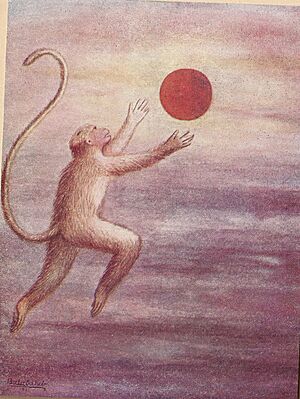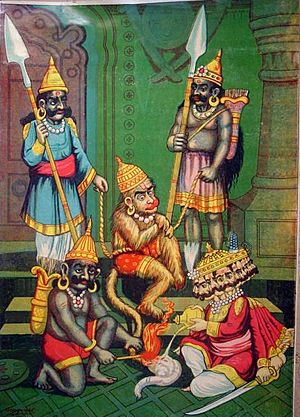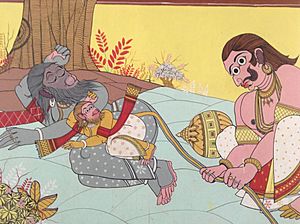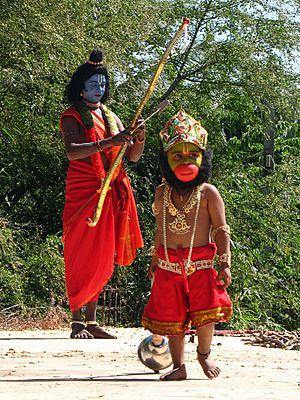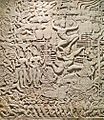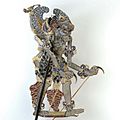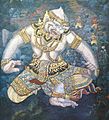Hanuman facts for kids
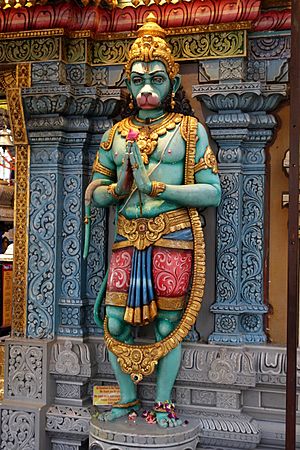
Hanuman is a very important god in Hinduism. He is also known as Maruti, Bajrangabali, and Anjaneya. People believe he is an avatar (a special form) of Shiva. Hanuman is seen as a protector of martial arts and a great example of courage.
You can find stories about him in famous Hindu books like the Ramayana, the Mahabharata, and various Puranas.
Hanuman is often shown with other main characters from the Ramayana, such as Rama, Sita, and Lakshmana. He usually carries weapons like a gada (mace) (a type of club) and a thunderbolt (called a vajra).
Contents
What Does His Name Mean?
The exact meaning of the name "Hanuman" is not fully clear. In the Hindu group of gods, deities often have many names. Each name usually describes a special quality or a great deed they performed. One idea for "Hanuman" means "one with a disfigured jaw." This comes from an old story.
Birth and Childhood
Hanuman's parents were Anjana and Kesari. He is also known as the son of the god Vayu, who is the god of wind. He grew up in a place called Kishkindha.
A famous story says that one morning, Hanuman was very hungry. He saw the bright, red sun rising. He thought it was a giant, ripe fruit and bravely jumped up to eat it! The king of the gods, Indra, saw this. He threw his powerful thunderbolt at Hanuman. It hit Hanuman on his jaw, and he fell to Earth, seemingly dead with a broken jaw.
Hanuman's father, Vayu (the wind god), became very angry. He pulled all the air away from Earth. This caused huge problems for everyone living there. To fix this, Shiva stepped in and brought Hanuman back to life. After Hanuman was alive again, Vayu brought the air back to Earth.
In another version of this story, Hanuman was burned to ashes by the sun's heat. The gods gathered his ashes and bones from land and sea. They put him back together, but one piece of his jawbone was missing. His great-grandfather asked Surya (the Sun god) to bring him back to life. Surya did, but Hanuman was left with a slightly disfigured jaw.
Hanuman had amazing powers and incredible strength. He was immortal, meaning he could not die. Fire, water, and wind could not harm him. He could also travel anywhere as fast as the wind.
Hanuman in the Ramayana
When Rama's wife, Sita, was kidnapped, Rama and his brother Lakshmana sent groups to search for her. One group traveled to the very south of India. From there, they could see the island of Lanka (which is now Sri Lanka) across the ocean. The group wanted to explore the island, but no one could swim or jump that far.
However, Hanuman used his special powers. He grew as big as a mountain and flew across the water to Lanka!
Once he landed, he saw a city filled with the king of Lanka, Ravana, and his demon followers. So, Hanuman shrunk himself down to the size of an ant. He then snuck into the city. After searching, he found Sita in a garden, guarded by demon warriors. When they all fell asleep, he met with Sita. He told her how he found her. She explained that Ravana had kidnapped her and was forcing her to marry him soon. Hanuman offered to rescue her right away. But Sita refused. She believed her husband, Rama, must be the one to rescue her. This was a common belief in ancient India.
What happened next has different versions. A common story is that after seeing Sita, Hanuman started destroying the garden. This led to his capture. No matter how it happened, he ended up captured in Ravana's court. Ravana laughed when Hanuman told him that Rama was coming to get Sita back. Ravana ordered his servants to set Hanuman's tail on fire as punishment.
But every time they wrapped an oil-soaked cloth on his tail, Hanuman made his tail grow longer. This meant they needed more and more cloths! This went on until Ravana had enough and told them to light it. When his tail was lit, Hanuman quickly shrunk his tail back. He then used his superhuman strength to break free from his ropes. He jumped out a window and leaped from rooftop to rooftop, setting buildings on fire. Soon, much of the city was burning! After this amazing act, Hanuman flew back to India.
When he returned, he told his group what had happened. They rushed back to Kishkindha, where Rama was waiting for news. Hearing that Sita was safe, Rama gathered the army of Sugriva. They marched towards Lanka. This was the start of the famous Battle of Lanka.
During the long battle, Hanuman was a brave general in the army. In one fierce fight, Lakshmana, Rama's brother, was badly wounded. It was thought he would die without a special herb from a Himalayan mountain. Hanuman was the only one who could travel there so quickly. So, he was sent to get the herb.
When he arrived, he saw many herbs on the mountainside. He didn't want to pick the wrong one. So, he grew as big as a mountain himself! He then ripped the entire mountain from the Earth and flew it back to the battle. This act is perhaps his most famous. It is said that a piece of this mountain fell down. Today, "Mount Roomassala" is believed to be that fallen piece.
In the end, Rama showed his divine powers as a form of the God Vishnu. He defeated Ravana and the demon army. Finally, Rama returned to his home in Ayodhya to rule as king. After giving gifts to everyone who helped him, Rama gave Hanuman a gift. Hanuman threw it away! Many officials were confused and angry. Hanuman replied that he didn't need a gift to remember Rama. He said Rama would always be in his heart. Some officials were still upset and asked for proof. Hanuman then bravely tore open his own chest! Inside, there was an image of Rama and Sita on his heart.
Now proven as a true follower, Rama healed him and offered him immortality. But Hanuman refused. He only asked for a place at Rama's feet to worship him forever. Touched by this, Rama blessed him with immortality anyway. Like Shesha Nag, Hanuman would live on even after the kalpa (the destruction of the universe).
Hanuman in the Mahabharata
Centuries after the Ramayana, during the time of the Mahabharata, Hanuman was living quietly in a forest. He was almost forgotten. One day, his spiritual brother, Bhima, who was also a son of the god Vayu, passed by. Bhima was looking for flowers for his wife. Hanuman sensed this and decided to teach Bhima a lesson. Bhima was known for boasting about his superhuman strength. (At this time, supernatural powers were rarer than in the Ramayana stories).
Bhima found Hanuman lying on the ground, looking like a weak old monkey. He asked Hanuman to move, but Hanuman refused. Stepping over someone was very disrespectful back then. So, Hanuman suggested Bhima lift his tail to make a path. Bhima happily agreed, but he could not lift the tail at all!
Bhima, now humbled, realized that the frail monkey must be a god. He asked Hanuman to show his true form. Hanuman revealed himself, surprising Bhima. The brothers then hugged. Hanuman told Bhima that he would soon be part of a terrible war. He promised Bhima that he would sit on the flag of his brother Arjuna's chariot. From there, he would shout a battle cry for Bhima that would scare their enemies. Happy with this, Hanuman left his brother to continue his search. After that war, Hanuman was not seen again until the early 1600s.
Significance
In the 1600s, in northern and western India, Hanuman became a symbol of strength and dedication. People looked to him when they faced difficulties.
Later, during and after the time when India was ruled by other countries, Hanuman became a cultural hero. He represented the right of Hindu people to practice their spiritual and religious beliefs (dharma). Many groups, both political and religious, have named themselves after him. In parades, men dressed as Hanuman, along with women dressed as gopis (milkmaids) of god Krishna, show their pride in their heritage, culture, and religious beliefs.
Temples and Shrines
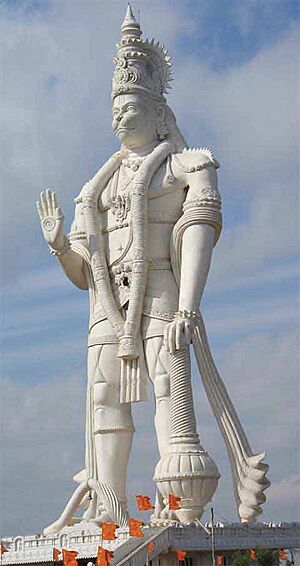
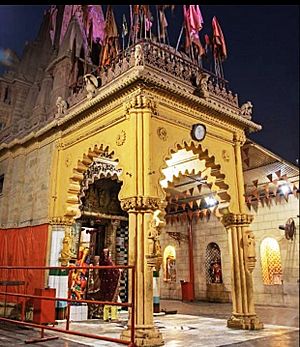
Hanuman is worshipped very often all over India. Tuesday and Saturday are especially popular days to visit Hanuman temples. Some people choose to fast (not eat) partially or fully on these two days.
Here are some major temples and shrines dedicated to Hanuman:
- The oldest known temple just for Hanuman is in Khajuraho. It dates back to about 922 CE.
- Mahavir Mandir in Patna, Bihar, India, is one of the holiest Hindu temples for Hanuman.
- Bajrang Bali Hanuman temple is in Lakdikapool, Hyderabad.
- Hanumangarhi, Ayodhya, is a 10th-century temple dedicated to Hanuman.
- Shri Panchmukhi Hanuman Mandir is a 1,500-year-old temple in Karachi, Pakistan. It is very special to Pakistani Hindus. It is the only temple in the world with a natural (not man-made) statue of Hanuman, called a (Swayambhu).
- Jakhu temple in Shimla, Himachal Pradesh, has a huge 108-foot (33-meter) statue of Hanuman. It is also the highest point in Shimla.
- The tallest Hanuman statue is the Veera Abhaya Anjaneya Swami. It stands 135 feet tall at Paritala, near Vijayawada in Andhra Pradesh. It was built in 2003.
- Chitrakoot in Madhya Pradesh has the Hanuman Dhara temple. It features a five-faced (panchmukhi) statue of Hanuman. It is located inside a forest. This temple and Ramghat, a few kilometers away, are important Hindu pilgrimage sites.
- In the 18th century, rulers in Pune gave more money to Hanuman temples than to temples of other gods like Shiva or Ganesh. Even today, there are more Hanuman temples in Pune than for other gods.
- One of the main Hanuman temples is Hanuman Temple Salangpur in Salangpur, Gujarat. It also has a 54-foot tall statue of Hanuman.
- Outside India, a large Hanuman statue was built by Tamil Hindus near the Batu caves in Malaysia. Another 85-foot (26-meter) Karya Siddhi Hanuman statue was built by descendants of Hindu workers in Carapichaima in Trinidad and Tobago. There is also a Karya Siddhi Hanuman Temple in Frisco, Texas in the United States.
Festivals and Celebrations
Hanuman is a main character in the yearly Ramlila celebrations in India. He is also important in traditional plays in Southeast Asia, especially in Thailand, and in Bali and Java, Indonesia. Ramlila is a play that re-enacts the life of Rama from the ancient Hindu epic Ramayana. In 2008, UNESCO recognized the Ramlila festivities as one of the "Intangible Cultural Heritages of Humanity."
Hanuman's birthday is celebrated by some Hindus as Hanuman Jayanti. In most of India, it falls in the Hindu month of Chaitra (March and April). However, in parts of Kerala and Tamil Nadu, Hanuman Jayanti is celebrated in the month of Mārgaḻi (December and January). On this festive day, people gather at Hanuman temples before sunrise. They spend the day reciting prayers and reading stories about the victory of good over evil.
Lineage
Some sources say that Hanuman never married and had no children. However, some regional stories say that Hanuman married Suvarchala, the daughter of Surya (the Sun-God).
There is also a story that once, when Hanuman was flying over the sea to Lanka, a drop of his sweat fell into the mouth of a crocodile. This crocodile later gave birth to a baby monkey. This monkey baby was found by Ahiravana. He raised the baby, named him Makardhwaja, and made him the guard of the gates of Patala, Ahiravana's kingdom. One day, Hanuman went to save Rama and Lakshmana from Ahiravana. He had to fight Makardhwaja and defeated him. Later, after learning the truth and saving Rama and Lakshmana, Hanuman made his son the king of Patala.
Images for kids
-
Standing Hanuman, Chola Dynasty, 11th century, Tamil Nadu, India
-
Many 14th-century and later Hanuman images are found in the ruins of the Hindu Vijayanagara Empire.
-
Roadside Hanuman shrine south of Chennai, Tamil Nadu.
-
Hanuman murti seated in meditation in lotus asana
-
Hanuman relief in Prambanan temple, Indonesia
-
Hanuman wayang (puppetry) in Indonesian culture
See also
 In Spanish: Hánuman para niños
In Spanish: Hánuman para niños


